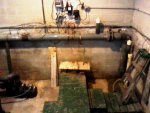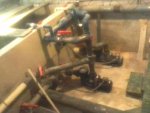Our basic problem is that the ORP will drift up, especially during a warm, sunny day even when the chlorine concentration is not increasing (and sometimes even dropping). And I have not been able to find any reference to such a problem either on the internet or from our local technician.
We have a 220,000 gal outdoor pool in Tampa FL. We had a Polaris Watermatic C660 but after the following problem developed and nothing else worked, we had installed a Hayward 2000. However, the problem persists. Starting last fall (2013), The ORP would drift upward during the day after the chlorine feed had stopped. It would reach its peak about midday and then drift down. All the time the chlorine level would remain constant at the desired level (2-3 PPM). It often seemed to be more pronounced on sunny days. After the new regulator was put in, the technician from our pool supplier tried to regulate it and let the CYA stabilizer drop to a very low concentration (<< 20 ppm) and it seems to work okay. However that was during the cool, and often cloudy weather. Lately our weather is warming up and the temperature has been getting into the 80s with sunny days. The last couple days, the ORP was set at 760. It dropped low enough during the night to feed chlorine to 1 ppm. But as the day progressed, the ORP rose above the set point and continued rising until the top cut-off of 840 even though the chlorine actually decreased because of the sun. This was similar to last fall, although then we kept the "CYA at about 30 ppm and the chlorine about 3 ppm. I have not been able to find anything about the ORP rising high like this without an accompanying rise in the chlorine, and was advised that it was probably a problem with the regulator, so we got the new one. However, the problem persists. The technician from our supplier is at a loss as to how to explain this. He did some testing and suspected a possible contamination of the CYA, but, with the warm sunny weather the situation is persisting/returning. I have a fairly good background in chemistry and can think of nothing else than some kind of contaminant that get oxidized in the sunlight, but cannot imagine what that would be. We get our water from a well on the property, but things worked ok during last summer. Any ideas, anyone?
Rimoc
We have a 220,000 gal outdoor pool in Tampa FL. We had a Polaris Watermatic C660 but after the following problem developed and nothing else worked, we had installed a Hayward 2000. However, the problem persists. Starting last fall (2013), The ORP would drift upward during the day after the chlorine feed had stopped. It would reach its peak about midday and then drift down. All the time the chlorine level would remain constant at the desired level (2-3 PPM). It often seemed to be more pronounced on sunny days. After the new regulator was put in, the technician from our pool supplier tried to regulate it and let the CYA stabilizer drop to a very low concentration (<< 20 ppm) and it seems to work okay. However that was during the cool, and often cloudy weather. Lately our weather is warming up and the temperature has been getting into the 80s with sunny days. The last couple days, the ORP was set at 760. It dropped low enough during the night to feed chlorine to 1 ppm. But as the day progressed, the ORP rose above the set point and continued rising until the top cut-off of 840 even though the chlorine actually decreased because of the sun. This was similar to last fall, although then we kept the "CYA at about 30 ppm and the chlorine about 3 ppm. I have not been able to find anything about the ORP rising high like this without an accompanying rise in the chlorine, and was advised that it was probably a problem with the regulator, so we got the new one. However, the problem persists. The technician from our supplier is at a loss as to how to explain this. He did some testing and suspected a possible contamination of the CYA, but, with the warm sunny weather the situation is persisting/returning. I have a fairly good background in chemistry and can think of nothing else than some kind of contaminant that get oxidized in the sunlight, but cannot imagine what that would be. We get our water from a well on the property, but things worked ok during last summer. Any ideas, anyone?
Rimoc



